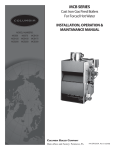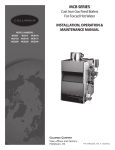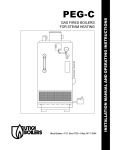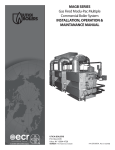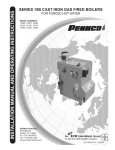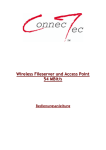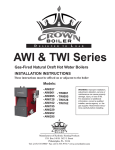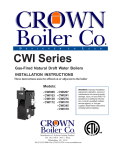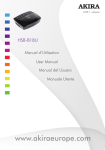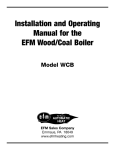Download Utica MGB100 Operating instructions
Transcript
GAS FIRED BOILERS FOR FORCED HOT WATER Utica Boilers, • P.O. Box 4729 • Utica, NY 13504 INST ALLA TION MANU AL AND OPERA TING INSTR UCTIONS INSTALLA ALLATION MANUAL OPERATING INSTRUCTIONS MGB TABLE OF CONTENTS Safety Symbols & Warnings ........................................................................ Page 2 Installation Procedure .................................................................................. Page 3 Ventilation and Combustion Air .................................................................... Pages 4-6 Connecting Supply and Return Piping .......................................................... Pages 6-9 Vent Installation ........................................................................................... Page 9 Vent System modification ............................................................................ Page 10 Vent Damper Installation and Instructions .................................................... Page 11 Connecting Gas Service ............................................................................. Page 12 Electrical Wiring ........................................................................................... Page 13 Thermostat Installation ................................................................................. Page 13 Lighting Instructions ..................................................................................... Pages 13-16 Normal Sequence of Operation .................................................................... Page 16 General Instructions ..................................................................................... Pages 17-19 Checking Gas Input Rate to Boiler ............................................................... Pages 19-20 Replacement Parts Lists .............................................................................. Pages 20-25 Ratings and Data ......................................................................................... Page 26 Dimensions .................................................................................................. Page 27 KEEP THIS MANUAL NEAR BOILER RETAIN FOR FUTURE REFERENCE SERIES MGB CAST IRON GAS FIRED BOILERS C.S.A. Certified for Natural gas or Propane INSTALLATION MANUAL AND OPERATION INSTRUCTIONS Published February 1989 Revised June 1998 Printed in USA Made In USA PAGE 1 Tested for 100 lbs. ASME Working Pressure Safety Symbols The following defined symbols are used throughout this manual to notify the reader of potential hazards of varying risk levels. DANGER DANGER - Indicates an imminently hazardous situation which, if not avoided, WILL result in death or serious injury. WARNING WARNING - Indicates a potentially hazardous situation which, if not avoided, COULD result in death or serious injury CA UTION CAUTION CAUTION - Indicates a potential hazardous situation which, if not avoided, MAY result in minor or moderate injury. It may also be used to alert against unsafe practices. IMPOR TANT! IMPORT READ ALL INSTRUCTIONS BEFORE INSTALLING. WARNING: 1. Keep boiler area clear and free from combustible materials, gasoline and other flammable vapors and liquids. 2. DO NOT obstruct air openings to the boiler room. 3. Modification, substitution or elimination of factory equipped, supplied or specified components may result in property damage, personal injury or the loss of life. 4. To the owner: Installation and service of this boiler must be performed by a qualified installer. 5. To the installer: Leave all instructions with the boiler for future reference. 6. When this product is installed in the Commonwealth of Massachusetts the installation must be performed by a Licensed Plumber or Licensed Gas Fitter. WARNING: ALL INSTALLATIONS OF BOILERS AND VENTING SHOULD BE DONE ONLY BY A QUALIFIED EXPERT AND IN ACCORDANCE WITH THE APPROPRIATE UTICA BOILERS MANUAL. INSTALLING OR VENTING A BOILER OR ANY OTHER GAS APPLIANCE WITH IMPROPER METHODS OR MATERIALS MAY RESULT IN SERIOUS INJURY OR DEATH DUE TO FIRE OR TO ASPHYXIATION FROM POISONOUS GASES SUCH AS CARBON MONOXIDE WHICH IS ODORLESS AND INVISIBLE. PAGE 2 INST ALLA TION PR OCEDURE INSTALLA ALLATION PROCEDURE WARNING: Improper installation, adjustment, alteration, service or maintenance can cause injury or property damage. 1. The installation must conform to the requirements of the authority having jurisdiction or, in the absence of such requirements, to the latest revision of the National Fuel Gas Code, ANSI Z223. (Available from the American Gas Association, 8501 E. Pleasant Valley Road, Cleveland, Ohio 44134). Reference should also be made to local gas utility regulations and other codes in effect in the area in which the installation is to be made. When installed in Canada: The latest revision of the CAN1-B149.1 and/or B149.2 Installation Codes for GasBurning Equipment and/or local codes. 2. Where required by the authority having jurisdiction, the installation must conform to American Society of Mechanical Engineers Safety Code for Controls and Safety Devices For Automatically Fired Boilers, ANSI/ASME No.CSD-1. 3. This boiler series is classified as a Category 1 and the vent installation shall be in accordance with Part 7 of the National Fuel Gas Code noted above when installed in the United States. In Canada refer to the CAN1-B149.1 and or B149.2 Installation Codes for Gas-Burning Equipment. Also refer to applicable provisions of the local building codes. 4. This boiler has met safe lighting and other performance criteria with the gas manifold and control assembly on the boiler per the latest revision of ANSI Z21.13/CGA 4.9. 5. The boiler shall be installed such that the gas ignition system components are protected from water (dripping, spraying, rain, etc.) during appliance operation and service, (circulator replacement, condensate trap, control replacement, etc.). 6. LOCATE BOILER on level, solid base as near the chimney as possible and centrally located with respect to the heat distribution system as practical. 7. Allow 24 inches at the front and right side for servicing and cleaning. 8. When installed in a utility room, the door should be wide enough to allow the largest boiler part to enter, or to permit replacement of another appliance such as a water heater. 9. FOR INSTALLATION ON NON-COMBUSTIBLE FLOORS ONLY . For installation on combustible flooring special base part no. 325-2-8.00 must be used. The boiler can not be installed on carpeting. Minimum clearances to combustible construction are: TOP ........................................18 IN. FRONT ...................................ALCOVE FLUE CONNECTOR ...............6 IN. REAR ......................................4 IN. CONTROL SIDE .....................9 IN. OTHER SIDE ..........................3 IN. NOTE: Greater clearances for access should supersede fire protection clearances. PAGE 3 VENTILA TION & COMB USTION AIR VENTILATION COMBUSTION WARNING: AIR OPENINGS TO COMBUSTION AREA MUST NOT BE OBSTRUCTED. BY FOLLOWING THE INSTRUCTIONS BELOW, ADEQUATE COMBUSTION AIR CAN BE MAINTAINED COMB USTION AIR REQ UIREMENTS COMBUSTION REQUIREMENTS MODEL NUMBER MGB MGB 38 MGB 50 MGB 75 MGB 100 MGB 125 MGB 150 MGB 175 MGB 200 MGB 225 MGB 275 MGB 300 (MINIMUM SQUARE INCHES OPENING) *UNCONFINED AREA **CONFINED AREA OUTSIDE INSIDE OUTSIDE COMBUSTION AIR COMBUSTION COMBUSTION VERTICAL HORIZONTAL AIR 1 SQ. IN AIR 1 SQ. IN. DUCTS DUCTS /5000 BTU/HR /1000 BTU/HR 1 SQ. IN. 1 SQ. IN. (SEE FIG. 4) (SEE FIG. 3) /4000 BTU/HR /2000 BTU/HR 8 100 10 19 10 100 13 25 15 100 19 38 20 100 25 50 25 125 32 63 30 150 38 75 35 175 44 88 40 200 50 100 45 225 57 113 55 275 69 138 60 300 75 150 * Unconfined area: A space whose volume is not less than 50 cubic feet per 1000 BTU per hour of all appliances installed in that space (cubic feet of space = height x width x length). ** Confined area: A space whose volume is less than 50 cubic feet per 1000 BTU per hour of all appliances installed in that space (cubic feet of space = height x width x length). 1. Ventilation of the boiler room must be adequate to provide sufficient air to properly support combustion per the latest revision of the National Fuel Gas Code, ANSI Z223.1 section 5.3. 2. When a boiler is located in an unconfined space in a building or conventional construction frame, masonry or metal building, infiltration normally is adequate to provide air for combustion and ventilation. However, if the equipment is located in a building of unusually tight construction (See the national Fuel Gas Code, Ansi Z223.1 section 1.7), the boiler area should be considered as a confined space. In this case air for combustion and ventilation shall be provided according to part 5 on page 5. If there is any doubt, install air supply provisions in accordance with the latest revision of the National Fuel Gas Code. 3. When a boiler is installed in an unconfined space, in a building of unusually tight PAGE 4 construction, air for combustion and ventilation must be obtained from outdoors or from spaces freely communicating with the outdoors. A permanent opening or openings having a total free area of not less than 1 square inch per 5,000 BTU per hour of total input rating of all appliances shall be provided. Ducts may be used to convey makeup air from the outdoors and shall have the same cross-sectional area of the openings to which they are connected. 4. When air for combustion and ventilation is from inside buildings, the confined space shall be provided with two permanent openings, one starting 12 inches from the top and one 12 inches from the bottom of the enclosed space. Each opening shall have a minimum free area of 1 square inch per one thousand (1000) BTU per hour of the total input rating of all appliances in the enclosed space, but must not be less than one hundred (100) square inches. These openings must freely communicate directly with other spaces of sufficient volume so that the combined volume of all spaces meets the criteria for an unconfined space. 5. When the boiler is installed in a confined space and all air is provided from the outdoors the confined space shall be provided with one or two permanent openings according to methods A or B. When ducts are used, they shall be of the same cross sectional area as the free area of the area of the openings to which they connect. The minimum dimension of rectangular air ducts shall be not less than 3 x 3 inches or 9 square inches. A. When installing two openings, one must commence within 12 inches from the top and the other within 12 inches from the bottom of the enclosure. The openings shall communicate directly, or by ducts, with the outdoors or spaces (crawl or attic) that freely communicate with the outdoors. One of the following methods must be used to provide adequate air for ventilation and combustion. 1. When directly communicating with the outdoors, each opening shall have a minimum free area of 1 square inch per 4,000 BTU per hour of total input rating of all equipment in the enclosure. See figure 2 below. FIGURE 1 FIGURE 2 2. When communicating with the outdoors by means of vertical ducts, each opening shall have a minimum free area 1 square inch per 4,000 BTU per hour of total input rating of all appliances in the enclosed space. See figure 3 on page 6. 3. If horizontal ducts are used, each opening and duct shall have a minimum free area 1 square inch per 2,000 BTU per hour of total input rating of all appliances in the enclosed space. See figure 4 on page 6. B. One permanent opening, commencing within 12 inches of the top of the enclosure, PAGE 5 FIGURE 3 FIGURE 4 shall be permitted where the equipment has clearances of at least 1 inch from the sides, 1 inch from the back, and 6 inches from the front of the boiler. The opening shall directly communicate with the outdoors or shall communicate through a vertical or horizontal duct to the outdoors or spaces (crawl or attic) that freely communicate with the outdoors. The openings must have a minimum free area of 1 square inch per 3000 Btu per hour of the total input rating of all equipment located in the enclosure. The free area must be no less than the sum of the areas of all vent connectors in the confined space. 6. In calculating free area using louvers, grilles or screens for the above, consideration shall be given to their blocking effect. Screens used shall not be smaller than 1/4 inch mesh. If the free area through a design of louver or grill is known, it should be used in calculating the size opening required to provide the free area specified. If the design and free area is not known, it may be assumed that wood louvers will have 20-25% free area and metal louvers and grilles will have 60-75% free area. Louvers and grilles should be fixed in the open position or interlocked with the boiler so they are opened automatically during the boiler operation. CONNECTING SUPPL Y AND RETURN PIPING SUPPLY IMPORTANT: Circulators in the following illustrations are mounted on the system supply side, but mounting on the system return side is also acceptable practice. 1. Connect supply and return piping as suggested in figure 5 on page 7, when the boiler is used in connection with refrigerated systems. A. The chilled medium MUST BE PIPED IN PARALLEL with the boiler. B. Use appropriate valves to prevent the chilled medium from entering the heating boiler. a. During heating cycle open valves A and B, close valves C and D. b. During cooling cycle, open valves C and D, close valves A and B. C. Maintain a minimum clearance of one inch to hot water pipes. 2. When the boiler is connected to heating coils located in air handling units where they may be exposed to refrigerated air circulation, the boiler piping system MUST BE supplied with flow control valves or other automatic means to prevent gravity circulation of the boiler water during the cooling cycle. PAGE 6 BYPASS PIPING FIGURE 5 FIGURE 6 3. Hot water boilers installed above radiation level must be provided with a low water cutoff device. 4. When a boiler is connected to a heating system that utilizes multiple zoned circulators, each circulator must be supplied with a flow control valve to prevent gravity circulation. 5. Hot water boilers and system must be filled with water and maintained to a minimum pressure of 12 pounds per square inch. 6. Bypass piping is an option which gives the ability to adjust the supply boiler water temperature to fit the system or the condition of the installation. This method of piping, however, is not typically required for baseboard heating systems. Typical installations where bypass piping is used are as follows: A. This method is used to protect MIXING VALVE PIPING boilers from condensation forming due to low temperature return water. Generally noticed in large converted gravity systems or other large water volume systems. See figure 6 above. B. These methods are used to protect systems using radiant panels and the material they are encased in from high temperature supply water from the boiler and protect the boiler from condensation. See figure 7 at right and 8 on page 8. NOTE 1: When using bypass piping, adjust valves A and B until desired system temperature is obtained. NOTE 2: Bypass loop must be same size piping as the supply and return piping. PAGE 7 FIGURE 7 PRIMARY SECONDARY PIPING WITH BY PASS FIGURE 8 7. Installation using circulators is shown in figure 9 below. FIGURE 9 8. Installation using zone valves is shown in figure 10 on page 9. 9. For further piping information refer to the I=B=R Installation and Piping Guide. PAGE 8 FIGURE 10 WARNING: ALL INSTALLATIONS OF BOILERS AND VENTING SHOULD BE DONE ONLY BY A QUALIFIED EXPERT AND IN ACCORDANCE WITH THE APPROPRIATE UTICA BOILERS MANUAL. INSTALLING OR VENTING A BOILER OR ANY OTHER GAS APPLIANCE WITH IMPROPER METHODS OR MATERIALS MAY RESULT IN SERIOUS INJURY OR DEATH DUE TO FIRE OR TO ASPHYXIATION FROM POISONOUS GASES SUCH AS CARBON MONOXIDE WHICH IS ODORLESS AND INVISIBLE. WARNING: VENT INST ALLA TION INSTALLA ALLATION This boiler shall not be connected to any portion of a mechanical draft system operating under positive pressure. 1. The vent pipe must slope upward from the boiler not less then 1/4 inch for every 1 foot to the vent terminal. 2. Horizontal portions of the venting system shall be supported rigidly every 5 feet and at the elbows. No portion of the vent pipe should have any dips or sags. 3. This boiler series is classified as a Category 1 and the vent installation shall be in accordance with chapter 7 and 10 of the National Fuel Gas Code noted above or applicable provisions of the local building codes. 4. Inspect chimney to make certain it is constructed according to NFPA 211. The vent or vent collector shall be Type B or metal pipe having resistance to heat and corrosion not less than that of galvanized sheet steel or aluminum not less than 0.016 inch thick (No. 28 Ga). 5. Connect flue pipe from draft hood to chimney. Bolt or screw joints together to avoid sags. Flue pipe should not extend beyond inside wall of chimney. Do not install manual damper in flue pipe or reduce size of flue outlet except as provided by the latest revision of ANSIZ223.1. Protect combustible ceiling and walls near flue pip with fireproof insulation. Where two or more appliances vent into a common flue, the area of the common flue must be at least equal to the area of the largest flue plus 50 percent of the area of each additional flue. PAGE 9 VENT SY STEM MODIFICA TION SYSTEM MODIFICATION When an existing boiler is removed from a common venting system, the common venting system is likely to be too large for the proper venting of the appliances remained connected to it. If this situation occurs, the following test procedure must be followed: REMOVAL OF BOILER FROM VENTING SYSTEM At the time of removal of an existing boiler, the following steps shall be followed with each appliance remaining connected to the common venting system placed in operation, while the other appliances remaining connected to the common venting system are not in operation. A. Seal an unused opening in the common venting system. B. Visually inspect the venting system for proper size and horizontal pitch and determine there is no blockage or restriction, leakage, corrosion and other deficiencies which could cause an unsafe condition. C. Insofar as is practical, close all building doors and windows and all doors between the space in which the appliances remaining connected to the common venting system are located and other spaces of the building. Turn on clothes dryers and any other appliance not connected to the common venting system. Turn on any exhaust fans, such as range hoods and bathroom exhausts, so they operate at maximum speed. Do not operate a summer exhaust fan. Close fireplace dampers. D. Place in operation the appliance being inspected. Follow the lighting instructions. Adjust thermostat so appliance will operate continuously. E. Test for spillage at the draft hood relief opening after 5 minutes of main burner operation. Use the flame of a match or candle, or smoke from a cigarette, cigar or pipe. F. After it has been determined that each appliance remaining connected to a common venting system properly vents when tested as outlined above, return doors, windows, exhaust fans, fireplace dampers and any other gas burning appliances to their previous condition of use. G. Any improper operation of the common venting system should be corrected so the installation conforms with the latest revision of the National Fuel Gas Code, ANSI Z223.1. When resizing any portion of the common venting system, the common venting system should be resized to approach the minimum size as determined using the appropriate tables in appendix G in the latest revision of the National Fuel Gas Code, ANSI Z223. PAGE 10 VENT D AMPER INST ALLA TION AND INSTR UCTIONS DAMPER INSTALLA ALLATION INSTRUCTIONS INSTALLATION NOTE: Refer to Figure 11for steps 1 - 7. 1. Place Vent Damper on or as close to vent outlet of boiler as possible. See figure 12 below. 2. Remove Vent Damper Motor cover. 3. Remove locknut from connector at the end of the Damper wire harness. 4. Feed Damper and Damper wire harness connectors through bracket hole on Damper Motor frame. 5. Replace and tighten locknut onto Damper wire harness connector, 6. Plug Damper connector into socket on Damper Motor frame. 7. Replace Damper Motor cover. 8. Wire Damper in accordance with figure 11below. FIGURE 11 FIGURE 12 INSTRUCTIONS 1. Ensure that only the boiler is serviced by the Vent Damper. See Figure 12, above. 2. Clearance of not less than 6 inches between Vent Damper and combustible material must be maintained. Additional clearance should be allowed for service of Vent Damper. 3. Vent Damper must be in the open position when appliance main burners are operating. 4. The Vent Damper position indicator must be in a visible location following installation. 5. The thermostat's heat anticipator must be adjusted to match the total current draw of all controls associated with the boiler during a heating cycle. PAGE 11 CONNECTING GAS SERVICE 1. Connect gas service from meter to control assembly in accordance with ANSI Z223.1 and local codes or utility. A ground joint union should be installed for easy removal of gas control for servicing. A drip leg or trap must be installed at the bottom of a vertical section of piping at the inlet to the boiler. A pipe compound resistant to the action of liquified petroleum gases must be used on all threaded pipe connections. Check with the local utility for location of manual shutoff valve if required. See figure 13 below. 2. The gas line should be of adequate size to prevent undue pressure drop and never smaller than the pipe size of the main gas control valve. See chart below. 3. To check for leaks in gas piping, use a soap and water solution or other approved method. WARNING: DO NOT USE AN OPEN FLAME. 4. Disconnect the boiler from the gas supply piping system during any pressure testing of the gas piping. After reconnecting, leak test the gas connection and boiler piping before placing the boiler back into operation. Maximum Capacity of Pipe in Cubic Feet of Gas Per Hour (Gas pressure = 0.5 psig or less, pressure drop = .5 in.w/c) Nominal Iron Pipe Size 10' 20' 30' 40' 60' 80' 100' 1/2" 175 120 97 82 66 57 50 3/4" 360 250 200 170 138 118 103 1" 680 465 375 320 260 220 195 1400 950 770 660 530 460 400 1.1/4" Length of Pipe (Feet) For additional information refer to “Table C” of the National Fuel Gas Code Handbook. FIGURE 13 PAGE 12 ELECTRICAL WIRING SEE ADDENDUM " A" FOR WIRING DIAGRAMS AND COMPONENT CODING. Electrical wiring must conform with the National Electrical Code, ANSI/NFPA No. 70-1990 when installed in the United states, the CSA C22.1 Canadian Electrical Code, Part 1, when installed in Canada, and/or the local authority having jurisdiction. WARNING: 1.When an external electrical source is utilized, the boiler, when installed MUST BE electrically grounded in accordance with these requirements. 2. Install a fused disconnect switch between boiler and meter at a convenient location. THERMOST AT INST ALLA TION THERMOSTA INSTALLA ALLATION 1. Thermostat should be installed on an inside wall about four feet above the floor. 2. NEVER install a thermostat on an outside wall. 3. Do not install a thermostat where it will be affected by: A. Drafts B. Hot or Cold Pipes C. Sun Light D. Lighting Fixture E. Television F. A Fireplace or Chimney 4. Check thermostat operation by raising and lowering thermostat setting as required to start and stop the burners. 5. Instructions for the final adjustment of the thermostat are packaged with the thermostat (adjusting heating anticipator, calibration, etc.) LIGHTING INSTRUCTIONS WARNING: IF YOU DO NOT FOLLOW THESE INSTRUCTIONS EXACTLY, A FIRE OR EXPLOSION MAY RESULT CAUSING PROPERTY DAMAGE, PERSONAL INJURY OR LOSS OF LIFE. Before any procedures are attempted on this appliance, it is necessary to determine if the ignition system is electric or standing pilot. If you are un-certain, contact the manufacturer before proceeding. CA UTION: CAUTION: Before lighting any type of pilot burner (standing or intermittent), make certain the hot water boiler and system are full of water to minimum pressure of 12 lbs. per square inch in the system, and also make certain that the system is vented of air. Set the operating control of thermostat to a “below” normal setting. Refer to the following appropriate lighting instruction. PAGE 13 LIGHTING PROCEDURE FOR BOILER WITH INTERMITTENT PIL OT SY STEMS PILO SYSTEMS STEMS.. FOR YOUR SAFETY READ BEFORE OPERATING. A. This appliance is equipped with an ignition device which automatically lights the pilot. Do not try to light the appliance by hand. B. Before operating, smell all around the appliance area for gas. Be sure to smell next to the floor because some gas is heavier than air and will settle on the floor. CA UTION: WHAT TO DO IF YOU SMELL GAS CAUTION: * Do not try to light any appliance. * Do not touch any electrical switches; do not use any phones in your building. * Immediately call your gas supplier from a neighbor’s phone. Follow the gas supplier's instructions. * If you cannot reach your gas supplier, call the fire department. C. Use only your hand to push in or turn the gas control knob. Never use tools. If the knob will not push in or turn by hand, don’t try to repair it. Call a qualified service technician. Force or attempted repair may result in a fire or explosion. D. Do not use this appliance if any part has been under water. Immediately call a qualified service technician to inspect the appliance and to replace any part of the control system and any gas control which has been under water. OPERA TING INSTR UCTIONS FOR OPERATING INSTRUCTIONS INTERMITTENT PIL OT SY STEMS PILO SYSTEMS 1. STOP! Read the safety information in the User’s Information Manual. 2. Set the thermostat to lowest setting. 3. Turn off all electric power to the appliance. 4. This appliance is equipped with an ignition device which automatically lights the pilot. Do not try to light the pilot by hand. See figure 14 below. 5. Remove access panel. 6. Turn gas control knob clockwise to “OFF”. 7. Wait (5) minutes to clear out any gas. If you then smell gas, STOP! Follow “What To Do If You Smell Gas” in the safety information above. If you don’t smell gas, go on to the next step. 8. Turn gas control knob counterclockwise to “ON”. 9. Replace access panel. 10. Turn on all electric power to the appliance. 11. Set thermostat to desired setting. 12. If the appliance will not operate, follow the instructions “To turn off gas to appliance”, on page 16, and call a qualified service technician or your gas supplier. FIGURE 14 PAGE 14 LIGHTING PROCEDURE FOR BOILER WITH CONTINUOUS PIL OT PILO FOR YOUR SAFETY READ BEFORE LIGHTING A. Read the warning at the beginning of the LIGHTING INSTRUCTIONS. (Page 13) B. This appliance has a pilot which must be lighted by hand. When lighting the pilot, follow these instructions exactly. C. Before lighting, smell all around the appliance area for gas. Be sure to smell next to the floor because some gas is heavier than air and will settle on the floor. See page 14 for WHAT TO DO IF YOU SMELL GAS. D. Use only your hand to push in or turn gas control knob or reset button. Never use tools. If the knob or reset button will not push in or turn by hand, don’t try to repair it, call a qualified service technician. Force or attempted repair may result in a fire or explosion. E. Do not use this appliance if any part has been under water. Immediately call a qualified service technician to inspect the appliance and to replace any part of the control system and any gas control which has been under water. LIGHTING INSTRUCTIONS FOR CONTINUOUS PIL OT PILO 1. STOP! Read the safety information at the beginning of these instructions. 2. Set the thermostat to the lowest setting. 3. Turn off all electric power to the appliance. 4. Remove access panel and burner door. 5. Turn gas control knob clockwise to "OFF". See figure's 15 & 16 below. NOTE #1: Some gas control knobs cannot be turned from "PILOT" to "OFF" unless knob is pushed in slightly. DO NOT FORCE. FIGURE 15 FIGURE 16 6. Wait (5) minutes to clear out any gas. If you then smell gas, STOP! Follow “What To Do If You Smell Gas”, on page 14. If you don't smell gas, go to the next step. 7. Find pilot. Follow metal tube from gas control. Depending on the model of the boiler, pilot is either mounted on the base or on one of the burner tubes. 8. Turn gas control knob counterclockwise to "PILOT". PAGE 15 9. Push in gas control knob or reset button if so equipped, all the way in and hold. Immediately light the pilot with a match. Continue to hold the gas control knob or reset button in for about 1 minute after the pilot is lit. Release knob or button, and it will pop up back up. Pilot should remain lit. If it goes out, repeat steps 5 through 9. * If knob or button does not pop up when released, stop and immediately call a qualified service technician or your gas supplier. * If the pilot will not stay lit after several tries, turn the gas control knob clockwise to "OFF". (See note #1), and call a qualified service technician or your gas supplier. 10. Replace burner door. 11. Turn gas control knob counterclockwise to "ON". 12. Replace access panel. 13. Turn on all electric power to the appliance. 14. Set thermostat to desired setting. TO TURN OFF GAS TO APPLIANCE 1. Set the thermostat to lowest setting. 2. Turn off all electric power to the appliance if service is to be performed. 3. Push in gas control knob slightly and turn clockwise to "OFF", DO NOT FORCE. 5. Call a qualified service technician. NORMAL SEQ UENCE OF OPERA TION SEQUENCE OPERATION On a call for heat, the thermostat will actuate, completing the circuit to the aquastat. The completed circuit to the aquastat will first activate the circulator and damper which will close an end switch inside the damper. This action will complete the circuit to the ignition system and ignition will take place. In the event the boiler water temperature exceeds the high limit setting on the boiler mounted aquastat, power will be interrupted between the aquastat and the ignition system. The power will remain off until the boiler water temperature drops below the high limit setting. The circulator will continue to operate under this condition until the thermostat is satisfied. In the event the flow of combustion products through the boiler venting system becomes blocked, the blocked vent safety switch will shut the main burner gas off. See figure 18, page 17. Similarly, if the boiler flueway becomes blocked, a flame rollout safety switch will shut the main burner gas off. See figuer 18, page 17. If either of these conditions occur, do not attempt to place the boiler back into operation. Contact a qualified service agency. PAGE 16 GENERAL INSTRUCTIONS Before seasonal start-up, have a competent service agency check the boiler for soot and scale in the flues, clean the burners and check the gas input rate to maintain high operating efficiency. CA UTION: CAUTION: Label all wires prior to disconnection when servicing controls. Wiring errors can cause improper and dangerous operation. Verify proper operation after service. The service agency or owner should make certain the system is filled with water to minimum pressure and open air vents, if used, to expel any air that may have accumulated in the system. Check the entire piping system and if any leaks appear, have them repaired. Many circulators like the one pictured in figure 17 below, require periodic servicing. The motor usually has openings at each end to lubricate the bearings. Put about one half teaspoon of SAE 20 or 30 non-detergent motor oil in each opening twice a year. CAUTION: DO NOT OVER OIL. FIGURE 17 FIGURE 18 Many circulators have an oil opening for the shaft bearing. This should be oiled at the same time for quiet operation. Follow the manufacturer's instructions for oiling the shaft bearing. The venting system should be inspected at the start of each heating season. Check the vent pipe from the boiler to the chimney for signs of deterioration by rust or sagging joints. Repair if necessary. Remove the vent pipe at the base of the chimney or flue and using a mirror, check vent for obstruction and make certain the vent is in good working order. The boiler flue gas passageways may be inspected by a light and mirror. Remove the burner door, figure 18. Place a trouble lamp in the flue collector through the draft relief opening. With PAGE 17 the mirror positioned above the burners, the flue gas passageways can be checked for soot or scale. The following procedure should be followed to clean the flue gas passageways: 1. Remove the burners from the combustion chamber by raising the burners up from the manifold orifices and pulling toward the front of the boiler. See figure 18 on page 17. 2. Disconnect the vent pipe from the draft hood. 3. Remove the top jacket panel. 4. Remove the combination flue collector and draft hood from the boiler castings by loosening the nuts on the hold down bolts located on each side of the collector. See figure 18 on page 17. 5. Place a sheet of heavy paper or similar material over the bottom of the base and brush down the flue passageways. The soot and scale will collect on the paper and is easily removed with the paper. With the paper still in place in the base, clean the top of the boiler castings of the boiler putty or silicone used to seal between the castings and flue collector. Make certain that chips are not lodged in the flue passageways. When the cleaning process is complete, restore the boiler components to their original position. Use boiler putty or IS-808 GE silicone, available from a Utica Boilers distributor, to seal around the flue collector and boiler castings. FIGURE 19 FIGURE 20 A visual check of the main burner and pilot flames should be made at the start of the heating season and again in mid-season. The main burner flame should have a well defined inner blue mantel with a lighter blue outer mantel. Check the burner throats and burner orifices for lint or dust obstruction. See figures 19 and 20 above. The pilot flame should envelop 3/8 to 1/2 inch of the tip of the pilot thermocouple, ignition/ sensing electrode or mercury sensor. See figure 21 on page 19. To adjust the pilot flame, remove the pilot adjustment cover screw (figures 14, 15, & 16 on pages 14 & 15), and turn the inner adjustment screw counterclockwise to increase or clockwise to decrease pilot flame. Be sure to replace cover screw after adjustment to prevent possible gas leakage. PAGE 18 The burners and pilot should be checked for signs of corrosion, rust or scale buildup. The area around the boiler must be kept clear and free of combustible materials, gasoline and other flammable vapors and liquids. The free flow of combustion and ventilating air to the boiler and boiler room must not be restricted or blocked. It is recommended that a qualified service agency be employed to make an annual inspection of the boiler and heating system. They are experienced in making the inspections outlined above, and, in the event repairs or corrections are necessary, trained technicians can make the proper changes for safe operation of the boiler. FIGURE 21 FIGURE 22 CHECKING GAS INPUT RA TE TO BOILER RATE Gas input to the boiler can be adjusted by removing the protective cap on the pressure regulator, (See figures 14, 15, & 16 on pages 14 & 15), and turning the screw clockwise to increase input and counterclockwise to decrease input. Natural gas manifold pressure should be set at approximately 3.5 inches water column. Propane gas manifold pressure should be set at approximately 11.0 inches water column. These manifold pressures are taken at the outlet side of the gas valve. See figures15 & 17 on pages14 & 15. To check for proper flow of natural gas to the boiler, divide the input rate shown on the rating plate by the heating value of the gas obtained from the local gas company. This will determine the number of cubic feet of gas required per hour. With all other gas appliances off, determine the flow of gas through the meter for two minutes and multiply by 30 to get the hourly rate. Make minor adjustments to the gas input as described above. Burner orifices should be changed if the final manifold pressure varies more than plus or minus 0.3 inches water column from the specified pressure. Primary air adjustment is not necessary, therefore air shutters are not furnished as standard equipment. Air shutters can be furnished on request where required by local codes or conditions. PAGE 19 CHECK SAFETY CONTROL CIRCUIT, after burner adjustments are made, for satisfactory operation. 1. Pilot: With main burner operating, turn the pilot gas adjusting screw clockwise until pilot gas is turned off. See figures 14, 15, & 16 on pages 14 & 15. Within 90 seconds the main gas control should close, shutting off the gas to the main burner. 2. High limit control (figure 22 on page 19). Remove cover and note temperature setting. Decrease this setting to minimum and operate boiler. When the boiler water temperature exceeds the control temperature setting, the control will open the circuit, closing the automatic main gas valve. MGB SERIES REPLA CEMENT P AR TS REPLACEMENT PAR ARTS ROLL OUT & SPILL SWIT CH OLLOUT SWITCH ITEM NO. PART NO. 1 2 3262001 AQ02101 3 HW06501 DESCRIPTION TEMP. SENSOR BRACKET CONTROL-FIXED TEMPERATURE THERMO (ROLLOUT SWITCH) SCREW - #6 X1/4 HEX HD THE ROLLOUT SWITCH IS LOCATED ON THE BASE AND FLUE COLLECTOR NOTE: THE QUANTITIES ABOVE ARE FOR EACH SWITCH. FIGURE 23 PAGE 20 OTY. 1 1 2 MGB SERIES REPLA CEMENT P AR TS - PIL OTS REPLACEMENT PAR ARTS PILO ITEM PART # NUMBER 1 2 3 1520001 HW-009.01 PB-011.03 PB-011.04 DESCRIPTION THERMOCOUPLE Q309A SCREW #8-18X1/2 PILOT STDG Q380 NAT PILOT STDG Q380 LP OTY. 1 4 1 ITEM PART # NUMBER 4 5 6 DESCRIPTION OTY. 32622001 PILOT BRACKET ASSY 24V 1 (THIS INCLUDES #5 & 2 SCREWS) 3261401 PILOT SHIELD 1 MS-003.03 PILOT TUBE 1/4"X20.1/2" AL. 1 FIGURE 24 ITEM PART # NUMBER 1 2 32623601 PB-011.01 PB-011.02 DESCRIPTION OTY. PILOT BRACKET ASSY SPARK 1 PILOT SPARK Q381 NAT 1 PILOT SPARK Q381 LP ITEM PART # NUMBER 3 4 5 FIGURE 25 PAGE 21 HW-009.01 PB00702 MS-003.03 DESCRIPTION SCREWS #8-18X1/2 PILOT IGNITION CABLE 30" PILOT TUBE 1/4"X20.1/2" AL. OTY. 2 1 1 MGB SERIES REPLA CEMENT P AR TS - B ASE REPLACEMENT PAR ARTS BASE ITEM PART # NUMBER 1 2 3 4 5 3352401 MGB50 (1) MGB125 (3) MGB200 (4) 5611601 5611602 5611603 5611604 5611605 5611606 3261201 3262701 3262801 32621001 32621002 32621003 356-2-1.01 356-2-1.02 356-2-1.03 356-2-1.04 356-2-1.05 356-2-1.0\6 HW-005.01 DESCRIPTION OTY. BURNER TUBE 1.3/4" MGB75 (2) MGB100 (2) MGB150 (3) MGB175 (4) MGB250 (5) MGB300 (6) BASE W/INSUL MGB50 1 BASE W/INSUL MGB75&100 BASE W/INSUL MGB125&150 BASE W/INSUL MGB175&200 BASE W/INSUL MGB225&250 BASE W/INSUL MGB275&300 BURNER DOOR MGB50 1 BURNER DOOR MGB75&100 BURNER DOOR MGB125&150 BURNER DOOR MGB175&200 BURNER DOOR MGB250 BURNER DOOR MGB300 MANIFOLD MGB50 1 MANIFOLD MGB75&100 MANIFOLD MGB125&150 MANIFOLD MGB175&200 MANIFOLD MGB225&250 MANIFOLD MGB275&300 SCREW 1/4-20X1/2 SELF TAP 4 ITEM PART # NUMBER 6 7 FIGURE 26 PAGE 22 VG-003.05 DESCRIPTION GAS VALVE VR8200H MGB50-150 24V NAT VG00307 GAS VALVE VR8200H MGB50-300 24V LP VG01101 GAS VALVE VR8204H MGB50-150 SPARK NAT VG01103 GAS VALVE VR8304H4 MGB175-300 SPARK NAT VG01104 GAS VALVE VR8304 MGB50-300 SPARK LP VG01201 GAS VALVE VR8300H4 MGB250 & 300 24V NAT VG01202 GAS VALVE VR8300H4 MGB175 & 200 24V NAT 355-1-5.01 ORIFICE #30 NAT MGB50, 100, 150, 200, 250, & 300 355-1-5.02 ORIFICE #31 NAT MGB125&175 355-1-5.03 ORIFICE #33 NAT MGB75 355-1-5.04 ORIFICE #47 LP MGB50, 100, 150, 200, 250, & 300 355-1-5.06 ORIFICE #49 LP MGB125&175 355-1-5.07 ORIFICE #50 LP MGB75 OTY. 1 1 MGB SERIES REPLA CEMENT P AR TS - J ACKETS REPLACEMENT PAR ARTS JA ITEM PART # NUMBER 1 2 3 4 5 31621501 31621502 31621503 31621504 31621505 31621506 31621507 3162704 3162706 3162707 3162708 3162501 3162502 3162503 3162504 3162505 3162506 3161101 3161102 3161103 3161104 3161105 3161106 3161201 3161202 3161203 3161204 3161205 3161206 DESCRIPTION OTY. PANEL - TOP MGB50 1 PANEL - TOP MGB75 & 100 PANEL - TOP MGB125 PANEL - TOP MGB150 PANEL - TOP MGB175 & 200 PANEL - TOP MGB225 & 250 PANEL - TOP MGB275 & 300 PANEL - LEFT MGB225-300 1 PANEL - LEFT MGB(L)50-200 PANEL - LEFT MGB(L)225-300 PANEL - LEFT MGB50-200 DRAFT DEFLECTOR MGB50 1 DRAFT DEFLECTOR MGB75/100 DRAFT DEFLECTOR MGB125/150 DRAFT DEFLECTOR MGB175/200 DRAFT DEFLECTOR MGB225/250 DRAFT DEFLECTOR MGB275/300 PNL LWR ACCES MGB50 1 PNL LWR ACCES MGB75/100 PNL LWR ACCES MGB125/150 PNL LWR ACCES MGB175/200 PNL LWR ACCES MGB225/250 PNL LWR ACCES MGB275/300 PANEL - BASE MGB50 1 PANEL - BASE MGB75 & 100 PANEL - BASE MGB125 & 150 PANEL - MGB175 & 200 PANEL - BASE MGB225 &250 PANEL - BASE MGB275 & 300 ITEM PART # NUMBER 6 7 8 9 10 FIGURE 27 PAGE 23 3162705 3162703 3162601 3162602 3162603 3162604 3162605 3162606 3462101 3462102 3462103 3462104 3462105 3462106 3462107 3462108 3462109 1182004 1182005 1182006 1182007 1182008 1182009 31621201 31621202 31621203 31621204 31621205 31621206 31621207 DESCRIPTION OTY. PANEL - RIGHT MGB 50-200 1 PANEL - RIGHT MGB 225-300 PANEL - REAR MGB50 1 PANEL - REAR MGB75 & 100 PANEL - REAR MGB125 & 150 PANEL - REAR MGB175 & 200 PANEL - REAR MGB225 & 250 PANEL - REAR MGB275 & 300 FLUE COL MGB50 1 FLUE COL MGB100 FLUE COL MGB150 FLUE COL MGB200 FLUE COL MGB225 & 250 FLUE COL MGB275 & 300 FLUE COL MGB125 FLUE COL MGB75 FLUE COL MGB175 DAMPER 4" MGB50 1 DAMPER 5" MGB75 DAMPER 6" MGB100 & 125 DAMPER 7" MGB150 & 175 DAMPER 8" MGB200, 225, & 250 DAMPER 9" MGB 275 & 300 PNL- UPPER ACCESS MGB50 1 PNL- UPPER ACCESS MGB75&100 PNL- UPPER ACCESS MGB125 PNL- UPPER ACCESS MGB150 PNL- UPPER ACCESS MGB175 & 200 PNL- UPPER ACCESS MGB225 & 250 PNL- UPPER ACCESS MGB275 & 300 MGB SERIES REPLA CEMENT P AR TS REPLACEMENT PAR ARTS HEA T EX CHANGER HEAT EXCHANGER ITEM NO 1 2 3 4 P/N MGB50 (0) MGB150 (2) MGB250 (4) 5 6 7 8 9 MGB50 (2) MGB150 (6) MGB250 (10) DESCRIPTION 100-2-2.01 100-2-1.01 B-LEFT HAND SECTION B-CENTER SECTION MGB75 (1) MGB100 (1) MGB125 (2) MGB175 (3) MGB200 (3) MGB225 (4) MGB275 (5) MGB300 (5) 100-2-3.01 B-RIGHT SECTION HW-011.01 TIE ROD 1/4X11.1/2 MGB75 & 100 HW-011.03 TIE ROD 1/4X15.1/2 MGB125 & 150 HW-011.05 TIE ROD 1/4X19.1/2 MGB175 & 200 HW-011.07 TIE ROD 1/4X23 MGB225 & 250 HW-011.09 TIE ROD 1/4X27 MGB275 & 300 HW06901 NUT 5/16-18 WISLOCK 43300976 PUSH NIPPLE 2" MACH. MGB75 (4) MGB100 (4) MGB125 (6) MGB175 (8) MGB200 (8) MGB225 (10) MGB275 (12) MGB300 (12) 3461601 BAFFLE (USED ON MGB75 & MGB175 ONLY) MGB75(4) 2 per flueway MGB175 (4) 1 per flueway HW-008.01 WASH-5/16 FLAT STL ZP HW-003.02 NUT-1/4-20 HEX-STL ZP FULLY ASSEMBLED HEAT EXCHANGERS 100-2-7.01 HEAT EXCHANGER 3 SECTION 100-2-7.02 HEAT EXCHANGER 4 SECTION 100-2-7.03 HEAT EXCHANGER 5 SECTION 100-2-7.04 HEAT EXCHANGER 6 SECTION 100-2-7.05 HEAT EXCHANGER 7 SECTION 100-2-7.06 HEAT EXCHANGER 2 SECTION FIGURE 28 PAGE 24 QTY. 1 1 2 6 4 2 MGB SERIES REPLA CEMENT P AR TS REPLACEMENT PAR ARTS PIPING & CONTROLS ITEM NO 1 2 3 4 5 6 7 8 9 10 11 12 13 14 15 16 17 P/N 37513301 37413602 PB00702 PF-006.07 HW-016.03 PF-008.03 PF-006.01 375-1-14.01 37519501 1010002 VR-001.01 AQ-020.01 GA-001.00 PF-005.11 PF-002.04 EF03601 PB00604 DESCRIPTION WIRE ROLLOUT/SPILL 28" HARNESS IGN TO G/V 18" PILOT IGNITION CABLE 30" PIPE - NPL 1.1/4X4.1/2 NPT DRAIN - SHORT PIPE - TEE 1.1/4X3/4X1.1/4 PIPE - 1.1/4" CLOSE NPL WIRE LOW VOLTAGE/DAMPER HARNESS CIRCULATOR 72" CONTROL L8148E1257 (AQUASTAT) RELIEF VALVE 30# WELL 3/4"X3" GAUGE - THERALTIMETER PIPE - NPL 3/4"X4" PIPE - ELBOW 3/4" 90° CLAMP #3600 WHITE PLT SPARK CTRL S8600 FIGURE 29 PAGE 25 QTY. 2 1 1 1 1 1 1 1 1 1 1 1 1 1 1 2 1 ATA TINGS AND D RA DA RATINGS ANE GAS OP NATURAL GAS AND PR OPANE PROP § § § ** † Boiler A.G.A. Heating I=B=R NetRating No. Input Capacity NetOutput Sq. Ft. HW o ∆ Natural Propane No. Recommended Gas Orifice Water of Air Cushion Orifice Drill Content Burners Tank Drill Size Size (Gals.) Btu/Hr. Btu/Hr. Btu/Hr @ 170 MGB 50 50,000 42,000 37,000 243 1 15 30 47 2.4 MGB 75 75,000 63,000 55,000 365 2 15 33 50 4.0 MGB 100 100,000 83,000 72,000 481 2 30 30 47 4.0 MGB 125 125,000 104,000 90,000 603 3 30 31 49 5.6 MGB 150 150,000 124,000 108,000 719 3 30 30 47 5.6 MGB 175 175,000 143,000 124,000 829 4 30 31 49 7.2 MGB 200 200,000 165,000 143,000 957 4 30 30 47 7.2 MGB 250 250,000 205,000 178,000 1189 5 30 30 47 8.8 MGB 300 299,999 243,000 214,000 1368 6 60 30 47 10.4 STANDARD EQUIPMENT: Boiler Jacket, Cast Iron Boiler Battery, Combination Aquastat Relay, Theraltimeter Gauge,Circulator with return piping to boiler, Main Gas Burners, Combination 24 Volt Gas Control (includes automatic gas valve, gas pressure regulator, automatic pilot, safety shutoff, pilot flow adjustment, pilotfilter), A.S.M.E. Relief Valve, Drain Cock, Spill Switch, Rollout Switch, Automatic Vent damper. Not shown are a wiring harness, thermocouple, and non-linting safety pilot. OPTIONAL EQUIPMENT: Intermittent Electric Ignition Pilot System. EXPLANATORY NOTES --All boilers are design certified for installation on noncombustible floor. --For installation on combustible floors use combustible floor kit. --Recommended chimney height 20 feet. In special cases where conditions permit, chimney height may be reduced to 10 feet. Refer to the latest revision of NFGC part 11. --Electric service to be 120 Volts, 15 Amps, 60 Hz. --The MEA number for the MGB series boiler is 19-79 Vol. II § For elevations above 2000 feet, ratings should be reduced at a rate of 4% for each 1000 feet above sea level. ∆ Tank sized for non-ferrous baseboard or radiant panel systems. Increase size for cast iron baseboard and radiation. † Base on 170' temperature in radiators. --Net I=B=R ratings include 15% allowance for normal piping and pick-up load. Manufacturer should be consulted on installations having otherthan normal piping and pick-up requirements. **For equivalent square feet of radiation, divide I=B=R output by 150. PAGE 26 MGB SERIES ANE GAS OP ATURAL GAS AND PR OPANE PROP DIMENSIONS FOR N NA Boiler Natural No. Gas Inlet MGB MGB MGB MGB MGB MGB MGB MGB MGB Pump size * 50 75 100 125 150 175 200 250 1/2" 1/2" 1/2" 1/2" 1/2" 3/4" 300 3/4" 1/2" 1/2" Dimensions A 11.1/8" 15 Supply & B 5.1/2" 7.1/2" C 4" 5" D 30.3/4" 30.3/4" E 36.1/4" 37.3/4" F 6" 6" 6.1/2" Return Tappings 1.1/4" 1.1/4" 1.1/4" 15 18.7/8" 18.7/8" 22.3/4" 22.3/4" 7.1/2" 6" 30.3/4" 37.1/4" 9.1/2" 9.1/2" 11.3/8" 11.3/8" 6" 7" 30.3/4" 30.3/4" 37.1/4" 37.3/4" 6.1/2" 1.1/4" 7" 1.1/4" 7" 8" 30.3/4" 30.3/4" 38.3/4" 38.3/4" 7" 8" 1.1/4" 1.1/4" 265.8" 30.1/2" 13.1/4" 15.1/4" 8" 9" 32.3/4" 32.3/4" 40.3/4" 42.3/4" 8" 10" 1.1/4" 1.1/4" * Propane gas inlet, all units, 1/2" Solutions you can be comfortable with. 37611601 PAGE 27 REV 14.1, May 2004




























